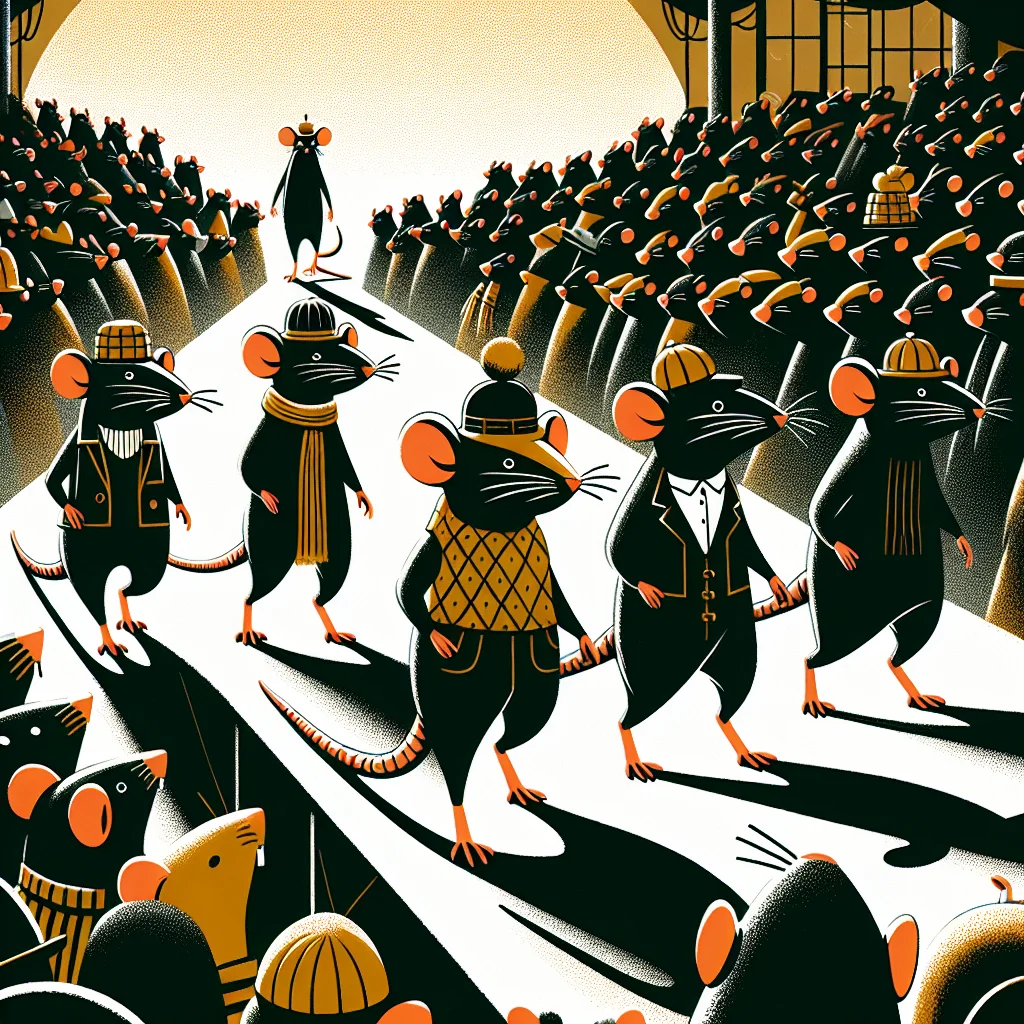
The bustling streets of Ratopolis are abuzz with a chic new trend—tiny hats made from recycled materials, captivating fashionistas and eco-conscious citizens alike. This stylish revolution not only highlights creative design but also promotes sustainability in the rat community's fashion scene.
Originating from the innovative minds of local rat designers, this movement showcases how recycled scraps transform into exquisite headwear. Pioneers like Stitch Tailor and Patch Whiskers embody this trend, crafting hats from discarded fabrics and repurposed bits. "These hats are the perfect blend of style and sustainability. It's a small step for a rat, but a giant leap for ratkind!" remarks Whiskers McTailor, a notable fashion enthusiast.
The tiny hat craze is reshaping Ratopolis' fashion landscape, encouraging both economic growth and environmental mindfulness. By utilizing recycled materials, designers cut costs and reduce waste. Events like the Ratopolis Tiny Hat Showcase celebrate these creations, drawing widespread acclaim and sparking larger conversations about eco-fashion.
Residents express palpable excitement and pride regarding this shift. "I never thought I'd see the day when trash became treasure," shares Squeaky Green, an avid environmental activist. "These hats are a testament to our creativity and resourcefulness." Even Cheddar Chic, a budding fashionista, aligns with this sentiment, stating, "It's not just a hat; it's a statement. We're tipping our hats to Mother Nature!"
Nevertheless, challenges persist. Sourcing high-quality recycled materials poses difficulties for designers, and some traditionalists view the trend as fleeting. Yet, the resilience shown by Ratopolis' talented artisans in overcoming these hurdles suggests a promising future for sustainable fashion.
Historically, Ratopolis has embraced diverse fashion trends, but none have woven environmental considerations so intricately into their fabric. This new wave signifies a broader shift towards conscientious consumerism among rats. Past efforts have seen varied success, often limited by practicality or acceptance.
Beyond the bustling hat stalls and workshops, voices from the edges of this movement share compelling insights. "I see tiny hats as a bridge," observes Dusty Quill, a lesser-known designer. "They connect us back to what's possible when innovation meets necessity."
Though some critics argue that focus should remain on other pressing issues, the enthusiasm and momentum behind this movement are undeniable. The tiny hat trend, while seemingly whimsical, raises profound questions about personal fashion choices and environmental impacts.
As this phenomenon unfolds, Ratopolis' populace is urged to reflect on their contributions to sustainability in their everyday attire. Let these stylishly small statements inspire greater change, reminding us all of the power contained in even the tiniest of gestures.
Looking for more in-depth news and exclusive content? Follow RAT TV for real-time updates, behind-the-scenes insights and the latest breaking news.
Originating from the innovative minds of local rat designers, this movement showcases how recycled scraps transform into exquisite headwear. Pioneers like Stitch Tailor and Patch Whiskers embody this trend, crafting hats from discarded fabrics and repurposed bits. "These hats are the perfect blend of style and sustainability. It's a small step for a rat, but a giant leap for ratkind!" remarks Whiskers McTailor, a notable fashion enthusiast.
The tiny hat craze is reshaping Ratopolis' fashion landscape, encouraging both economic growth and environmental mindfulness. By utilizing recycled materials, designers cut costs and reduce waste. Events like the Ratopolis Tiny Hat Showcase celebrate these creations, drawing widespread acclaim and sparking larger conversations about eco-fashion.
Residents express palpable excitement and pride regarding this shift. "I never thought I'd see the day when trash became treasure," shares Squeaky Green, an avid environmental activist. "These hats are a testament to our creativity and resourcefulness." Even Cheddar Chic, a budding fashionista, aligns with this sentiment, stating, "It's not just a hat; it's a statement. We're tipping our hats to Mother Nature!"
Nevertheless, challenges persist. Sourcing high-quality recycled materials poses difficulties for designers, and some traditionalists view the trend as fleeting. Yet, the resilience shown by Ratopolis' talented artisans in overcoming these hurdles suggests a promising future for sustainable fashion.
Historically, Ratopolis has embraced diverse fashion trends, but none have woven environmental considerations so intricately into their fabric. This new wave signifies a broader shift towards conscientious consumerism among rats. Past efforts have seen varied success, often limited by practicality or acceptance.
Beyond the bustling hat stalls and workshops, voices from the edges of this movement share compelling insights. "I see tiny hats as a bridge," observes Dusty Quill, a lesser-known designer. "They connect us back to what's possible when innovation meets necessity."
Though some critics argue that focus should remain on other pressing issues, the enthusiasm and momentum behind this movement are undeniable. The tiny hat trend, while seemingly whimsical, raises profound questions about personal fashion choices and environmental impacts.
As this phenomenon unfolds, Ratopolis' populace is urged to reflect on their contributions to sustainability in their everyday attire. Let these stylishly small statements inspire greater change, reminding us all of the power contained in even the tiniest of gestures.
Looking for more in-depth news and exclusive content? Follow RAT TV for real-time updates, behind-the-scenes insights and the latest breaking news.
Comments